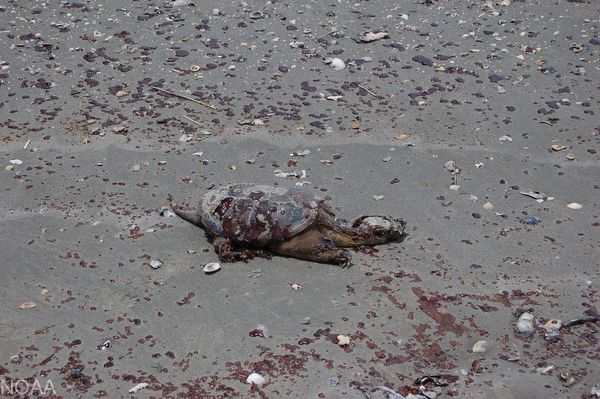More than two years after the Deepwater Horizon oil rig exploded and BP‘s well spewed millions of gallons of crude oil into the Gulf of Mexico, Greenpeace has finally been granted access to pictures that show the real impact of the oil on marine life. The pictures were obtained via a Freedom of Information Act request (FOIA) and show a very different side of the Gulf than what the media, BP, and the federal government have portrayed.
These images are among those obtained by Greenpeace:
The last photo shows a cleanup worker surrounded by garbage bags filled with dead Kemp’s Ridley sea turtles, a species that is critically endangered.
Greenpeace says that they are concerned about what else has been kept from the public, as most of the images or news reports we’re seeing revolve around positive stories. Pictures abound online of workers cleaning up tar ball-stained beaches or oil soaked animals, but none have come close to capturing the real impact of the disaster.
Hopefully these new pictures will open the nation’s eyes as to the potential disasters that could occur, and that have occurred with offshore drilling.
A few months after the oil started flowing into the Gulf, Greenpeace submitted 50 different FOIA requests to the federal government. Those that have been granted can be viewed on their Polluter Watch website.
Today, BP is currently drilling five wells in the Gulf of Mexico, which is the same number they were operating before the Deepwater Horizon explosion. But the company is hoping to get more rigs operational in the coming years, and recently announced plans to invest as much as $4 billion a year towards drilling operations in the Gulf of Mexico.
But BP is not the only danger lurking in the waters of the Gulf of Mexico. As I reported last year:
Reports from last summer (2010) identified 27,000 abandoned oil wells littered across the Gulf of Mexico. And these wells don’t even have the benefit of a cursory oil company-sponsored inspection – these wells have remained untouched for years, and no one knows if they are properly sealed off and secure.
To make things worse, there are an additional 3,500 “temporarily abandoned” wells in the Gulf. By declaring a well “temporarily abandoned,” companies can avoid all of the requirements that are supposed to ensure the safety of “permanently abandoned” wells, making these 3,500 the biggest time bombs in the Gulf.
As a resident of the Gulf Coast, I have received numerous photos and videos from local friends showing oil continuing to wash in with crashing waves, and tar balls sitting on our beaches. Beneath our famous “sugar white sands” you can find layers upon layers of oil-stained sands, not more than 6 inches from the surface. And yet tourism along the coast is once again thriving, as is local traffic to our beaches.
Many locals who weren’t directly affected by the oil spill – or not a part of an industry that was devastated by the disaster – continue to pretend like nothing happened. They ignore the fact that the tar balls they are walking across to play in the water have been found to contain deadly bacteria. They conveniently ignored the cleanup workers in hazmat suits plucking tar balls a few feet away from sunbathers. To them, if they can’t see the problem, it isn’t there.
But for those of us on the coast that have paid attention, we know all too well that the problem is not going away, and the effects of the oil disaster will be seen for generations. We know that reports continue to file in about deformed and dangerous seafood being caught in our waters.
We know that lives, careers, and businesses have been completely destroyed because of the negligence of companies like BP, Transocean, and Halliburton.
Nobody along the coast wants to continue to dwell on the negatives, including myself. But in order to prevent future disasters, we have to acknowledge the dangers, the consequences, and the ecological costs of our addiction to oil. And sadly, my hometown has become Exhibit A when it comes to the dangers of offshore oil drilling.
Subscribe to our newsletter
Stay up to date with DeSmog news and alerts











